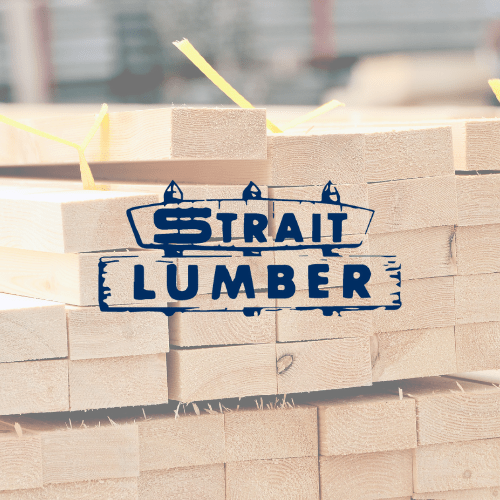Strait lumber is a term that refers to a specific type of lumber sourced from the unique ecosystems of the strait regions. This type of wood has garnered attention for its durability, aesthetic appeal, and versatility across various applications, making it a favored choice among builders, architects, and designers alike. In this article, we will explore the different facets of strait lumber, from its origins and characteristics to its applications and sustainability aspects.
As the demand for sustainable building materials continues to rise, understanding the properties and benefits of strait lumber becomes increasingly important. This article aims to provide a thorough overview of strait lumber, highlighting its advantages and addressing any misconceptions. We will delve into the environmental impact of harvesting strait lumber and explore how it fits into the broader context of sustainable forestry practices.
Whether you are a homeowner considering a new construction project, a builder looking for the best materials, or simply someone interested in sustainable practices, this comprehensive guide will equip you with the knowledge you need about strait lumber.
Table of Contents
- What is Strait Lumber?
- Characteristics of Strait Lumber
- Applications of Strait Lumber
- Sustainability of Strait Lumber
- Strait Lumber and Its Origins
- Data and Statistics
- Reliable Sources for Further Reading
- Conclusion
What is Strait Lumber?
Strait lumber is derived from trees that grow in the strait regions, characterized by their unique climate and soil conditions. The term encompasses various wood types, but typically includes species known for their strength and resistance to the elements. Commonly used strait lumber species include cedar, fir, and spruce, each offering distinct benefits for construction and woodworking.
Characteristics of Strait Lumber
Durability
One of the hallmark characteristics of strait lumber is its durability. The trees that produce this lumber are often subjected to harsh weather conditions, which leads to the development of dense and resilient wood. As a result, strait lumber can withstand rot, moisture, and pests, making it an ideal choice for both indoor and outdoor applications.
Aesthetic Appeal
Strait lumber is not only functional but also visually appealing. The natural grains and colors of the wood can enhance the aesthetic of any project. Whether used in flooring, cabinetry, or furniture, strait lumber can add a touch of elegance and warmth to spaces.
Applications of Strait Lumber
Strait lumber is incredibly versatile, finding its way into numerous applications across different industries:
- Construction: Used as structural beams, framing, and flooring.
- Furniture: Ideal for crafting durable and stylish furniture pieces.
- Outdoor Landscaping: Commonly used for decking, fencing, and garden structures.
- Decorative Elements: Employed in moldings, trims, and custom woodworking.
Sustainability of Strait Lumber
The sustainability of strait lumber is a crucial consideration in today's environmentally conscious society. Responsible harvesting practices ensure that the ecosystems from which the lumber is sourced remain intact. Many suppliers of strait lumber adhere to sustainable forestry certifications, such as FSC (Forest Stewardship Council), which guarantees that the wood is sourced from well-managed forests.
Strait Lumber and Its Origins
The origins of strait lumber are closely tied to the unique ecosystems found in strait regions around the world. These areas are often characterized by rich biodiversity and specific climatic conditions that contribute to the growth of high-quality timber. Understanding the geographical and ecological factors that influence the growth of these trees can provide insight into the quality and characteristics of the lumber they produce.
| Species | Common Uses | Durability Rating |
|---|---|---|
| Cedar | Outdoor furniture, siding | High |
| Fir | Framing, flooring | Moderate |
| Spruce | Musical instruments, furniture | Moderate |
Data and Statistics
According to the Sustainable Forestry Initiative, the demand for sustainably sourced wood, including strait lumber, has increased by over 30% in the past decade. This shift in consumer preference is driven by a growing awareness of environmental issues and the importance of sustainable building practices. Furthermore, studies show that using sustainably sourced wood can significantly reduce the carbon footprint of construction projects.
Reliable Sources for Further Reading
For those interested in delving deeper into the topic of strait lumber, the following sources provide valuable insights:
Conclusion
In summary, strait lumber stands out as a premium choice for a wide range of applications due to its durability, aesthetic appeal, and sustainable sourcing practices. As we continue to seek environmentally friendly building materials, understanding the benefits and characteristics of strait lumber will become increasingly important. We encourage readers to consider strait lumber for their next project and to share their thoughts or experiences in the comments section below.
Thank you for reading, and we hope to see you back for more informative articles on sustainable building practices and materials!
From The Earth Raytown: A Comprehensive Guide To Sustainable Living And Community Engagement
Exploring The Pool World: A Comprehensive Guide To The Art Of Billiards
Baylon Prestige Auto Sales: Your Ultimate Guide To Premium Vehicle Shopping


